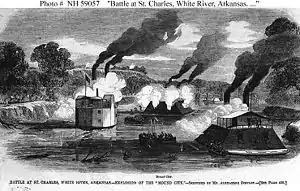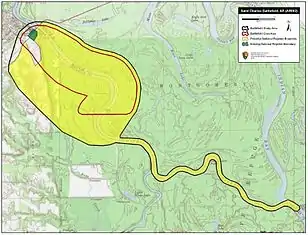Battle of Saint Charles
The Battle of St. Charles (also known as the Engagement at St. Charles) was a naval engagement and infantry battle during the American Civil War. It was fought on June 17, 1862, between eight Union ships, including USS Mound City, and several Confederate shore guns. A Confederate gun hit Mound City's steam drum, causing an explosion which resulted in heavy casualties: 105 of the 175-man crew were killed.[1] USS Mound City was then towed back to Memphis, Tennessee, and repaired.
| Battle of Saint Charles Engagement at St. Charles | |||||||
|---|---|---|---|---|---|---|---|
| Part of the Trans-Mississippi Theater of the American Civil War | |||||||
 Battle at St. Charles, White River, Arkansas: Explosion of USS Mound City | |||||||
| |||||||
| Belligerents | |||||||
|
|
| ||||||
| Commanders and leaders | |||||||
|
Col. Graham N. Fitch Cdr. Augustus H. Kilty | Capt. Joseph Fry (POW) | ||||||
| Strength | |||||||
| 8 Union ships | Several Confederate batteries | ||||||
| Casualties and losses | |||||||
| 177 | 26 | ||||||
Battle

On the morning of June 17, 1862, USS Mound City, St. Louis, Lexington, Conestoga, and transports, under the command of Commander Augustus Kilty, proceeded up White River towards St. Charles, Arkansas, attempting to resupply Major General Samuel R. Curtis's army near Jacksonport.
The Confederate gunboat Maurepas was hopelessly outclassed by the Federal ironclads. She was deliberately sunk in the river channel along with two steamboats. Two rifled 32-pounder guns were placed on the bluff along with four field guns, Captain Dunnington commanded the 79 gunners. Captain Williams directed 35 sharpshooters. Captain Joseph Fry was in overall command. The Mound City and St. Louis carried 13 guns each while the Lexington and Conestoga each mounted seven guns. In addition, the tug Tiger carried a 34-pound howitzer. There were three transports ferrying 1,000–1,500 soldiers under Colonel Graham N. Fitch.[2]
A few miles below Saint Charles, the 46th Indiana Infantry, under the command of Colonel Fitch, disembarked, formed a skirmish line, and proceeded upriver towards the Confederate batteries on Saint Charles' bluffs, under the command of Captain Joseph Fry of the Confederate States Navy. At the same time, the Union gunboats went upriver to engage the Confederate batteries; Mound City was hit and her steam drum exploded scalding most of the crew to death. More than 125 sailors from Mound City were killed, but the other ship was towed to safety. Col. Fitch halted the gunboat activities to prevent further loss and then undertook an attack on the Confederate batteries with his infantry. The 46th Indiana turned the Confederate flank which ended the firing from the batteries and left Saint Charles open to Union occupation.
The Confederates spiked their cannons and retreated. Hindman admitted a loss of six killed, one wounded, and eight missing, including Fry wounded and taken prisoner. Hindman claimed that his force inflicted 200 casualties, including 180 scalded to death on the Mound City.[3]
Battlefield Preservation
The site of the land portion of the battle is listed on the National Register of Historic Places as the St. Charles Battle Site, and the battle is memorialized by the St. Charles Battle Monument in downtown St. Charles.
More than 82 percent of the battlefield is protected from development by the US Fish and Wildlife Service and the Arkansas Natural Heritage Commission.[4]
References
![]() This article incorporates public domain material from the National Park Service document: "".
This article incorporates public domain material from the National Park Service document: "".
- Dimitry, John; Harrell, John M. (1899). Confederate Military History: Louisiana and Arkansas. 10. Atlanta, Ga.: Blue & Gray Press.
- Honnoll, W Danny. "Engagement at St Charles". Butler Center for Arkansas Studies. Retrieved 16 June 2017.
- Dimitry & Harrell 1899, p. 110.
- Dimitry & Harrell 1899, p. 111.
- "Saint Charles Battlefield Profile" (PDF). National Park Service. Retrieved 16 June 2017.